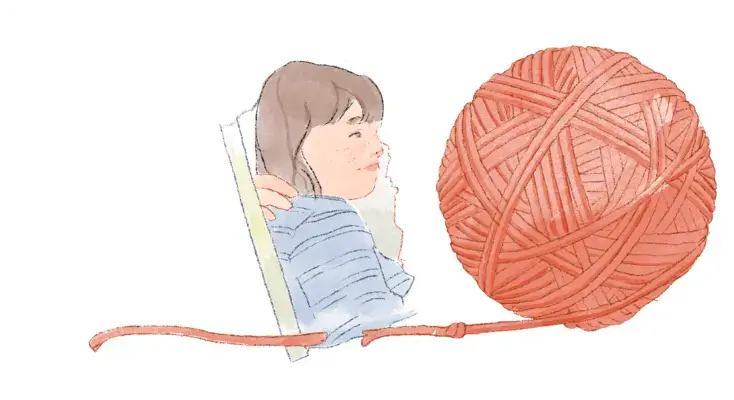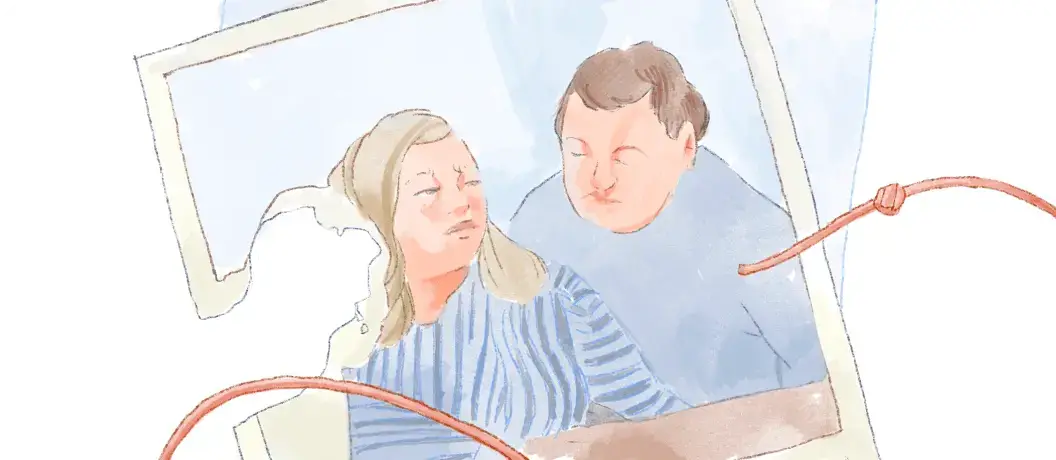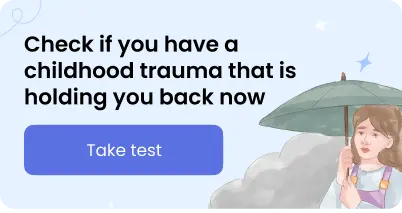People who have experienced trauma may face the mental equivalent of a maze with invisible walls as they try to make their way through the intricate web of emotional pain. One of these hidden childhood traumas is enmeshment, which is often hidden under parental “love” and “protection.”
Even though it can seem benign, enmeshment trauma can have long-lasting effects that change our relationships and how we see ourselves significantly.
In this article, we explore the causes of enmeshment trauma and how it affects our mental health. And most importantly, we elaborate on steps toward reclaiming autonomy and forging healthier relationships.
What is enmeshment trauma?
Families are made up of many connections between people and feelings that run deep within those connections.
Undoubtedly, the interpersonal relationships within a family system have an impact on children’s emotional development. One of the variants of relationships in a family can be described as enmeshment.
So, what is enmeshment in family relationships? According to family therapist Minuchin, in his Psychosomatic Families book, enmeshment means “a family organization in which boundaries between members are blurred, and members are overconcerned and overinvolved in each other’s lives, limiting individual autonomy.”
Although this messaging is often covert, the purpose of the enmeshment family system is to create emotional power and control within the family.
This tends to affect the kids. Instead of fostering the independence of the child, enmeshed parenting can lead to a sense of dependency that goes beyond typical family roles. This can also be a reason for mother wound and father wound.
In many cases, children struggle to form their own identity, have trouble expressing their feelings, and, in most cases, are not able to create a healthy, separate self. Therefore, it is commonly seen as a type of childhood trauma.
From this, it follows that enmeshment trauma happens when a child’s personal boundaries are routinely disregarded, and they cannot foster their autonomy from caregivers.
Enmeshment vs. closeness in family
The main thing about enmeshment trauma is its covert nature. It just may not feel apparent to anyone, even people within the family system.
To the outside world, enmeshed relationships might seem unusually close or even enviable, with parents who are deeply involved in their children’s lives. In reality, though, things are very different.
Closeness can be a beautiful thing—making us feel supported, understood, and valued. The distinction between closeness and enmeshment lies in the concept of boundaries. Healthy relationships and families respect personal space, individual decisions, and personal responsibility.
In contrast, enmeshed relationships erode the concept of self in favor of the ‘we’ collective, often hindering individual growth and expression.
For example, an enmeshed parent might demonstrate excessive affection, which on the surface seems loving.
Still, in reality, it may be a way to satisfy their own emotional needs, particularly if they are misattuning to their child’s desire to be affectionate.
Emotional enmeshment may make children feel less neglected or abandoned in the short term, but it can lead to anger and relationship problems in the long run and emotional baggage that carries into every new relationship.
Ultimately, true closeness involves mutual sharing, support, and respect for individual differences, while enmeshment involves control and a lack of differentiation between family members.
What causes enmeshment trauma?
Enmeshment trauma doesn’t occur in a vacuum. There are various factors that can contribute to a person’s development of enmeshment issues, including:
- Family Dynamics: Yes, the main cause, as we already mentioned. In families where there is a lack of overall emotional support, or conversely, where one’s identity is strongly tied to the family paradigm (such as in over-achieving families), there is a tendency to enmesh.
- Culture and Social Conditioning: Not only families but also certain cultures or societal structures may inadvertently encourage enmeshment behaviors. They can be deemed as a sign of love or loyalty, reinforcing the idea that individuality and independence are less important.
- Personal Attachment Styles: People with certain attachment styles, such as anxious-preoccupied or fearful-avoidant, may be more susceptible to developing enmeshment-related challenges and attachment trauma. This, according to attachment theory, also develops through family relationships.
9 signs of an enmeshed trauma
For you to start healing, you need to know how to spot the signs of enmeshment trauma. Here are some common signs that enmeshment might be a problem in your adult life and relationships:
- Feeling anxious or asking yourself, “Why do I feel so guilty?” about asserting your own needs and boundaries
- Avoiding conflict at all costs and becoming highly anxious when conflict arises
- A strong feeling that your identity depends on someone else’s approval or validation, fawning as trauma response
- Since emotional needs were not met in childhood, you can have trouble recognizing and controlling your feelings in adult life, too
- A history of codependent relationships or trauma bond experiences
- Difficulty making decisions without seeking approval or input from others
- Unexplained or disproportionate fear of abandonment or rejection
- Ongoing self-esteem issues and a lack of confidence in your ability to lead a self-directed life
- Adult responsibilities from a young age and often feeling responsible for the emotional health of a parent (parentification)
Enmeshment trauma examples
As an example, let’s take Jennette McCurdy’s autobiography “I am Glad My Mom Died,” which talks about an emotionally enmeshed family relationship. McCurdy wrote about enmeshment abuse, like how her mother bathed with her and enabled her to develop and maintain an eating disorder.
Other examples of family enmeshment trauma include:
- A child’s personal space is not physically respected, but more strikingly, emotional boundaries are routinely crossed. This could manifest as a parent expecting the child to meet his or her emotional needs or knowing every detail of the child’s inner world, sometimes at the expense of the child’s privacy.
- In enmeshed relationships, the child is often not seen as a separate individual but rather as an extension of the parent. The parents’ needs, wants, and wishes may be the central focus, overshadowing the development of the child’s own identity.
- When boundaries are not respected, the child may feel under a lot of pressure to keep things the same because they are afraid of being abandoned or feel terrible about standing up for themselves.
Romantic Enmeshment
In a nutshell, when partners become excessively emotionally dependent on each other, it can also lead to enmeshment trauma. Signs of enmeshment in romantic relationships may include:
- Partner’s lack of personal interests or social life outside the relationship
- Decisions made by one partner are heavily influenced by the other
- One partner’s need for constant support and reassurance from the other, at the expense of their own well-being and happiness

How enmeshment trauma can affect mental health
Difficulty Forming Relationships
Enmeshment can create a warped template for relationships. For instance, people who have experienced this type of trauma may struggle to form intimate connections without an overwhelming sense of emotional dependency and control.
Being unable to deal with this problem can make people feel alone. Why? In this sense, they do not want to keep getting caught up in the same complicated patterns when they are with other people.
Chronic stress and anxiety
Living in an enmeshed dynamic is inevitably stressful. People who do not have personal space, either literally or figuratively, may be more hypervigilant because they are always aware of other people’s emotional needs and expectations.
As a person feels responsible for the well-being of their entangled counterparts all the time. Even if it means sacrificing their own peace of mind, this constant stress can lead to anxiety disorders.
Development of co-dependency
Enmeshment may engender a co-dependent dynamic, where people rely on each other for self-worth and identity, not their own. This learned behavior can carry into other relationships, fostering an unhealthy cycle of over-reliance. In addition to the negative effects of trauma on mental health, co-dependency can also stunt personal development.
Identity confusion and low self-worth
Enmeshment trauma can hinder your ability to figure out who you are and what your needs, values, and goals are. Building a strong sense of self requires clear boundaries, which are not always available in close relationships. Over time, this can make people doubt their own worth and not know who they are when they are not with someone.
How to heal enmeshment trauma
Here are some tips for coping with enmeshment trauma.
Establishing Boundaries
One of the most important parts of healing from enmeshment trauma is learning to set and stick to personal boundaries. Mostly, this involves setting limits with others and also respecting their boundaries. Representing a two-way process is crucial for fostering balanced relationships.
Mindfulness and Self-Reflection
Practicing mindfulness and engaging in regular self-reflection can help trauma survivors reconnect with their own emotional needs and authentic self. Mindfulness exercises can maintain a sense of emotional regulation. This can help you reclaim your personal identity and sense of safety over time.
Cultivating Autonomy
People who have been through trauma can regain their independence by doing things that help them be more independent and self-sufficient. Having hobbies, setting goals, and making choices based on what you want are all empowering things that can help you deal with the learned helplessness of enmeshment.
Redefining Relationships
Breaking free from enmeshment might require reevaluating and changing the way you interact with people you already know. Steps to making healthy connections include communicating clearly and setting limits. As well as looking for help from people who can respect and support your independence.
Seeking Professional Help
Therapy, particularly with a trauma-focused therapist, can provide a safe space to explore the roots of enmeshment trauma and its impact on mental health. In therapy, you can process your experiences, challenge distorted beliefs, and develop adaptive coping strategies while receiving unconditional positive regard.
Advocating for Self-Care
Putting self-care first is a radical way for people who have been through enmeshment trauma to protect themselves. Take care of your physical health, and do things that make you happy and fulfilled. And making time for solitude and reflection are all part of this.
Disclaimer
This article is for general informative and self-discovery purposes only. It should not replace expert guidance from professionals.
Any action you take in response to the information in this article, whether directly or indirectly, is solely your responsibility and is done at your own risk. Breeze content team and its mental health experts disclaim any liability, loss, or risk, personal, professional, or otherwise, which may result from the use and/or application of any content.
Always consult your doctor or other certified health practitioner with any medical questions or concerns
Breeze articles exclusively cite trusted sources, such as academic research institutions and medical associations, including research and studies from PubMed, ResearchGate, or similar databases. Examine our subject-matter editors and editorial process to see how we verify facts and maintain the accuracy, reliability, and trustworthiness of our material.
Was this article helpful?




